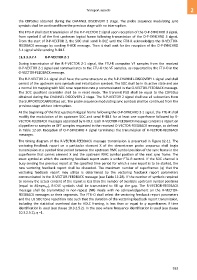Page 943 - 5G Basics - Core Network Aspects
P. 943
Transport aspects 2
the CDPSDus obtained during the CHANNEL DISCOVERY 2 stage. The probe sequence modulating sync
symbols shall be continued from the previous stage with no interruption.
The FTU-R shall start transmission of the R-P-VECTOR 2 signal upon reception of the O-P-SYNCHRO 3 signal,
from symbol 0 of the first upstream logical frame following transmission of the O-P-SYNCHRO 3 signal.
From the start of R-P-VECTOR 2, the SOC shall send R-IDLE until the FTU-R acknowledges the O-VECTOR-
FEEDBACK message by sending R-ACK message. Then it shall wait for the reception of the O-P-SYNCHRO
3-1 signal while sending R-IDLE.
12.3.3.3.7.4 R-P-VECTOR 2-1
During transmission of the R-P-VECTOR 2-1 signal, the FTU-R computes VF samples from the received
O-P-VECTOR 2-1 signal and communicates to the FTU-O the VF samples, as requested by the FTU-O in the
O-VECTOR-FEEDBACK message.
The R-P-VECTOR 2-1 signal shall have the same structure as the R-P-CHANNEL-DISCOVERY 1 signal and shall
consist of the upstream sync symbols and initialization symbols. The SOC shall be in its active state and use
a normal bit mapping with SOC tone repetition rate p communicated in the O-VECTOR-FEEDBACK message.
The SOC quadrant scrambler shall be in reset mode. The transmit PSD shall be equal to the CDPSDus
obtained during the CHANNEL DISCOVERY 2 stage. The R-P-VECTOR 2 signal shall use all subcarriers from
the SUPPORTEDCARRIERSus set. The probe sequence modulating sync symbols shall be continued from the
previous stage with no interruption.
At the beginning of the first upstream logical frame following the O-P-SYNCHRO 3-1 signal, the FTU-R shall
modify the modulation of its upstream SOC and send R-IDLE for at least one superframe followed by R-
VECTOR-FEEDBACK messages separated by R-IDLE. Each R-VECTOR-FEEDBACK message contains a report on
clipped error samples or DFT samples requested in the received O-VECTOR-FEEDBACK message, as defined
in Table 12-30. Reception of O-P-SYNCHRO 4 signal terminates the transmission of R-VECTOR-FEEDBACK
messages.
The timing diagram of the R-VECTOR-FEEDBACK message transmission is presented in Figure 12-11. The
vectoring feedback report on a particular element X of the downstream probe sequence shall begin
transmission at a symbol time period between the upstream RMC symbol position of the sync frame in the
superframe that carries element X and the upstream RMC symbol position of the next sync frame. The
exact symbol at which the vectoring feedback report starts is under FTU-R control. If the SOC channel is
busy sending the previous report at the specified time period for which a new report is to be started, the
new vectoring feedback report shall be discarded. The maximum number of superframes (q) that the
vectoring feedback report may utilize is determined by the vectoring feedback report parameters
communicated in the O-VECTOR-FEEDBACK message (see Table 12-28). If the number of symbols required
to convey the actual content of the report is less than the number of available upstream symbol positions
(equal to MF×q×sus), R-IDLE symbols shall be transmitted to fill up the gap. The R-VECTOR-FEEDBACK
message shall be transmitted in non-repeat (NR) mode with no acknowledgement on the R-VECTOR-
FEEDBACK messages or their segments. The FTU-O shall select the vectoring feedback report parameters
and the US SOC tone repetition rate such that the duration of the vectoring feedback report transmission,
including the statistical overhead due to HDLC framing, is less than or equal to q superframes if time
identification is used (see clause 10.3.2.5.2). In the case where frequency identification is used (see clause
10.3.2.5.1), q =1.
933

